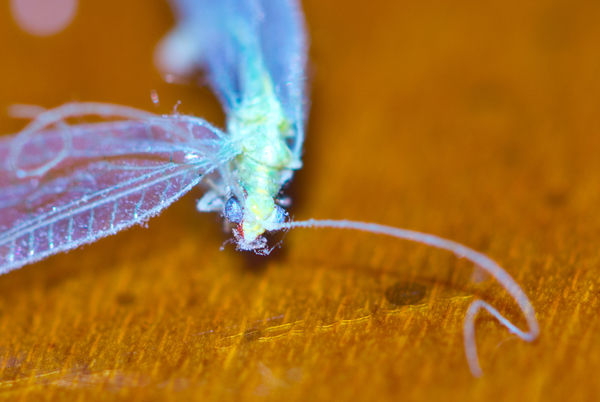Green Lacewing's Eyes
Feb 9, 2013 12:50:35 #
I recently got a 100mm Macro lens and am trying to learn how to use it. The files below show my attempt, but they are not sharp images. I'm wondering if I need a teleconverter lens or an extension tube, so that I can get really close, sharp pictures? Any help would be appreciated.



Feb 10, 2013 06:11:25 #
I think we might need a little more information on the settings that you used.
Looks as though you weren't using a tripod to start with and also a large aperture. Both not a good idea with macro.
The lighting looks a little odd. The Lacewing's not looking too well either...
You certainly don't need extension tubes or TC's at this stage of your macro career..
Looks as though you weren't using a tripod to start with and also a large aperture. Both not a good idea with macro.
The lighting looks a little odd. The Lacewing's not looking too well either...
You certainly don't need extension tubes or TC's at this stage of your macro career..
Feb 10, 2013 09:32:03 #
Kinopless wrote:
I think we might need a little more information on the settings that you used.
Looks as though you weren't using a tripod to start with and also a large aperture. Both not a good idea with macro.
The lighting looks a little odd. The Lacewing's not looking too well either...
You certainly don't need extension tubes or TC's at this stage of your macro career..
Looks as though you weren't using a tripod to start with and also a large aperture. Both not a good idea with macro.
The lighting looks a little odd. The Lacewing's not looking too well either...
You certainly don't need extension tubes or TC's at this stage of your macro career..
Kinopless, I think you've tought me a couple of valuable lessons, just by your questions.
Settings: f/3.5, 1/60 sec, ISO-100, -0.5 stop, 100mm, Program mode, with flash.
Did not use a tripod, and the Lacewing was dead, on the dining table, which I thought would make it "easier" to shoot since it wasn't moving. I will not try that again, but how to photographers get close, sharp pictures of insect eyes when they're flying around all the time?
Thanks for helping a newbee to macro.
Feb 10, 2013 17:49:49 #
Ah you have much to learn Grasshopper...
I think that the main thing is that you've made a start, there are many on this forum with enormous experience in macro-photography and I must defer to their collective knowledge.
Have a look at the dedicated macro forum, this link will take you straight there http://www.uglyhedgehog.com/s-102-1.html Read everything you can in there, it's a goldmine of information and very welcoming to those starting off in this field.
However I would add this. Forget the P (Program) mode for macro, most use Manual or A (Aperture priority). Use a tripod whenever you can.. The inbuilt flash on your camera is pretty much useless for macro, a separate flashhead or heads are regularly used as they provide an enormous amount of light when you are using small apertures of f16 and smaller. Small apertures are your friend in macro as they provide the extra depth of field. An added bonus is that the flash effectively gives you a high shutter speed that freezes motion.
It's a little daunting but when you get your first pinpoint sharp macro image you'll be hooked, patience is a handy attribute..
Practice technique on inanimate objects.
I've only covered a tiny part of the process. Keep asking questions, practicing and having fun. K.
I think that the main thing is that you've made a start, there are many on this forum with enormous experience in macro-photography and I must defer to their collective knowledge.
Have a look at the dedicated macro forum, this link will take you straight there http://www.uglyhedgehog.com/s-102-1.html Read everything you can in there, it's a goldmine of information and very welcoming to those starting off in this field.
However I would add this. Forget the P (Program) mode for macro, most use Manual or A (Aperture priority). Use a tripod whenever you can.. The inbuilt flash on your camera is pretty much useless for macro, a separate flashhead or heads are regularly used as they provide an enormous amount of light when you are using small apertures of f16 and smaller. Small apertures are your friend in macro as they provide the extra depth of field. An added bonus is that the flash effectively gives you a high shutter speed that freezes motion.
It's a little daunting but when you get your first pinpoint sharp macro image you'll be hooked, patience is a handy attribute..
Practice technique on inanimate objects.
I've only covered a tiny part of the process. Keep asking questions, practicing and having fun. K.
Feb 10, 2013 18:22:59 #
Kinopless wrote:
Ah you have much to learn Grasshopper... br br I ... (show quote)
Thanks, K. I should change my user name to Grasshopper!!!
Feb 10, 2013 18:23:00 #
Feb 11, 2013 05:34:00 #
(link removed for spamming)forum/tips-and-taking-photos/153064-photography-tip-introduction-to-high-magnification-macro-photography
You may find this interesting. K.
You may find this interesting. K.
If you want to reply, then register here. Registration is free and your account is created instantly, so you can post right away.
